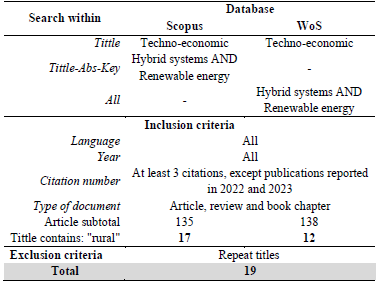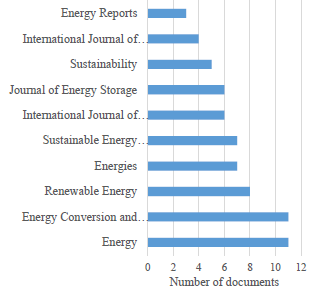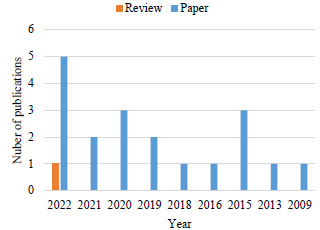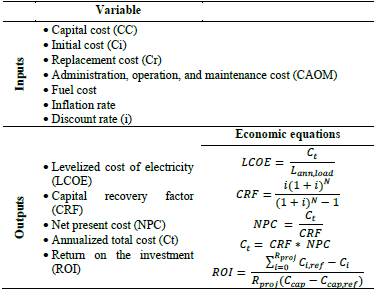1 Introduction
The high concentration of greenhouse gases (GHG) such as carbon dioxide, the impact of climate change on the planet, the need to ensure energy supply, and the diversification of the energy mix -necessary because the world is entering the declining phase of oil production - have placed the energy sector in the position of searching for new ways to generate energy [1].
There have been significant changes in the production, operation, and global distribution of electric energy over the past few years. The energy sector needs significant changes, and is constantly looking for new solutions that can help integrate green, sustainable, and equitable growth systems [2]. According to the International Energy Agency (IEA), the share of renewable energy sources should be three times higher in 2040, which would enable the technological advancement of non-conventional renewable energy sources.
Energy is a vital resource that promotes social well-being and fosters regional economic growth. According to the action plan for 2017-2022 of the Unit of Mining and Energy Planning (UPME), as seen in Colombia where, to the), there will be an increase in demand for energy of approximately 52% between 2016 and 2030 [3].
The energy sector has become one of the country's greatest challenges as it is part of the Sustainable Development Goals (SDGs) proposed by the UN. Colombia has assumed important environmental commitments in the Paris Agreement for the year 2030. Among them, the reduction of polluting emissions to maximum 170 million tons of equivalent CO2 since 2027, the definition of carbon budgets and the reduction of 40% of black carbon emission with 2014 level as reference [4] Likewise, the country has committed to aim rural electrification of the national territory that still does not have access to the resource (non-interconnected zones), reported as 53% [5], and the democratization of energy by 2050 by implementing a distributed generation of the resource, as is mentioned in the National Energy Plan (PEN) [1].
Approximately 53% of the country's territory is covered by the non-interconnected zones, i.e., the townships, municipalities, localities, and villages that are not connected to the national interconnected system [5]. The non-interconnected zones have 230,027 users spread throughout 18 departments, 76 municipalities, 16 unincorporated areas, and 1,797 localities. These areas produce energy primarily using diesel fuel, with a smaller amount of small hydroelectric plants and hybrid solar photovoltaic solutions [6]. These areas are characterized by their dispersion, low population density, low purchasing and consuming capacity, high rate of losses, and high rates of poverty, which lead to deficiencies in the energy sector, as well as in the transportation, educational, and health sectors [7]. Additionally, due to the difficulty in transmitting and distributing electricity from the national interconnected system to these areas, they have very high service cost.
The scenario previously described for the non-interconnected zones has prompted the national government to establish organizations, funds, policies, and projects that promote electrification in these areas. One of the main energy actors has been the Institute for Planning and Promotion of Energy Solutions (IPSE, called - Instituto de Planificación y Promoción de Soluciones Energéticas). Since, as of December 31, 2021, it has energized 67,400 new users in the non-interconnected zones with individual solar photovoltaic solutions and with networks [5]. This was done with the support of entities such as the Financial Support Fund for the Energization of Non-interconnected Areas (FAER, called -Fondo de Apoyo Financiero para la Energización de las Zonas Rurales Interconectadas), and the General Royalties System (SGR, for its name - Sistema General de Regalías).
However, the efforts made by the government have not been sufficient, and the expected results have not been obtained due to various factors. It is included: the absence of specific technical requirements for their interconnection and operation, the difficulty of providing a dimension to the costs to be incurred in the negotiation with the communities, the consumption policies that favor diesel fuel, the absence of qualified local human resources, the lack of knowledge of the real costs of investment and operation, and mainly due to the absence of self-sustaining financial models that ensure the administration, operation, and maintenance (AOM) of the system in an integral manner, over time in the communities [8].
This review article evaluates the techno-economic models used for the implementation of hybrid systems with renewable energy sources in rural or non-interconnected areas, focusing on the funding mechanisms, the procedure for economic assessment, the payback method, and the sustainability, economic and environmental impacts on the community.
This study pretended to continue a previous work reported by Maria J. Cardona and Y. U. López [9], where 31 papers were assessed related to the topic, where only one paper informed the funding source within a structured business and just another involved the community with the energy Project.
This review article assesses the recent techno-economic models used for the implementation of hybrid systems with renewable energy sources in rural or non-interconnected areas, through a systematic literature review (SLR), making use of the proposed methodology by Kitchenham described in his "Procedures for Performing Systematic Reviews" report [10].
This document is structured at the beginning with the description of the SLR, where the guiding questions were defined. The guiding questions are suggested for gathering and analyzing information. The databases used are presented and the way in which the search for the documents was carried out based on the equation used is explained in detail. The inclusion and exclusion criteria for the document selection is presented. A bibliometric analysis is included to one of the main database results. After the selection of the articles, the answers to each of the research questions are established and finally, the most relevant conclusions of the review are presented.
2 Materials and methods
2.1 Systematic Literature Review (SLR)
The procedure for the SLR is based on the synthesis method proposed by Kitchenham, through which all relevant information available on a particular topic is analyzed and interpreted [10]. This methodology is developed under a review protocol that specifies the research questions, the search process, data collection and analysis, and finally, the discussion on the research questions [11].
The SLR provides novel contributions to current knowledge by being based on a research question specific to the topic or area of interest, and by synthesizing and analyzing, the most relevant literature as an integrated system of knowledge that is complementary to other systems used and is not taken as isolated islands of information. Thus, systematic literature reviews make possible identifying research trends and important variables, supporting new research, exposing what has really worked in studies, as well as encouraging other lines of research [12].
In the field of engineering, and in particular, the areas of knowledge that are rapidly developing and undergoing constant interdisciplinary transformations, such as computing, energy, and electronics, the use of SLR brings great benefits by facilitating the search and compilation of data [13].
With the purpose of identifying the structured economic methods, models or procedures for funding generation, distribution, and commercialization of electricity projects from hybrid systems using renewable sources, specifically in rural applications (not connected to electric national systems or its equivalent in context), the literature review was conducted under the following research questions:
Q1: Which are the funding sources used in the projects?
Q2: Which are the economic variables of the models found?
Q3: What are the financial models applied to the development of the projects?
Q4: What challenges and suggestions have been identified for future projects?
The previous questions will be addressed by examining articles of a scientific nature found in the search in two recognized and important databases.
2.2 Search procedure
The scientific documents, used as the main elements for conducting the SRL, were extracted from the Elsevier's Scopus bibliographic database, which is a recognized database for its broad coverage of peer-reviewed literature, abstracts and citations. Scopus, by the year 2022 [14], covered more than 81 million of records. This database allows searching and analyzing documents in the fields of social science, technology, humanistic sciences, medicine and arts [15], from all journals without distinction by areas, i.e., using a single unified index [16].
In order not to bias the collection of information to a single source of information, the search for documents was complemented with the Web of Science (WoS). Platform developed by Thomson Reuters, which contains the most rigorously selected scientific information in the areas of science, social sciences and arts. It is found in the most prestigious journals worldwide, with approximately 8,500 publications until 2020 [17]. This tool is also recognized for being the most complete on any subject and allows access to citations of journal articles, books and printed material [18]. Unlike Scopus, this database includes only two of its eight indexes in its Journal Citations Reports (JCR), excluding the humanities [16].
Thus, both search platforms have excellent data analysis without remarkable differences. They provide very good quality resources to their users to support research that ensures reliability, veracity, and impact. However, although these two databases are of great prestige and integrity individually, the challenge was to use both in an integrated manner.
With the databases defined, the ideal search equation is designed to extract specific scientific documents adjusted to the research topic, which would provide answers to the questions posed. This is done through a process of combining keywords with the inclusion and exclusion of certain search criteria, as shown in Table 1. The following conventions were used for the Scopus database: Article title (Tittle), Abstract (Abs), Keywords (Key). In the case of WoS the previous conventions were also used and the "All" convention was added, which includes the search in all reference sections due to the restriction of this platform that prevented limiting the search of terms only in title, abstract and keywords.
Likewise, the results were discriminated by language, year of publication, type of documents such as full articles, bibliographic reviews and book chapters, excluding conferences and conference reviews. The results included reports with number of citations higher than three, and articles published as of 2022 and those that are about to be published in 2023 were allowed with a smaller number of citations.
Thus, 135 publications were gathered from the Scopus database and 138 from the WoS database. The final filter of containing the word "rural" in the title was applied. 17 and 12 articles were obtained, respectively, with rural applications, which were filtered one after the other to identify and eliminate the repeated ones, thus obtaining 19 documents in total to perform the SLR.
3 Results and discussion
The publications extracted from the Scopus database were passed through a bibliometric analysis using the quantitative research tool Bibliometrix [19]. The use of the bibliometric tool was to synthetize the research findings by topics and trends.
The Scopus database yielded 135 articles that fully complied with the equation and search criteria established for the development of the SRL. 129 correspond to scientific articles and only six to review articles. These publications have been published between 2009 and 2022 and, came from 58 sources of information (journals, books, and reviews). The results reported 489 different authors in 10 countries around the world, mainly from India, Iran, and Pakistan.
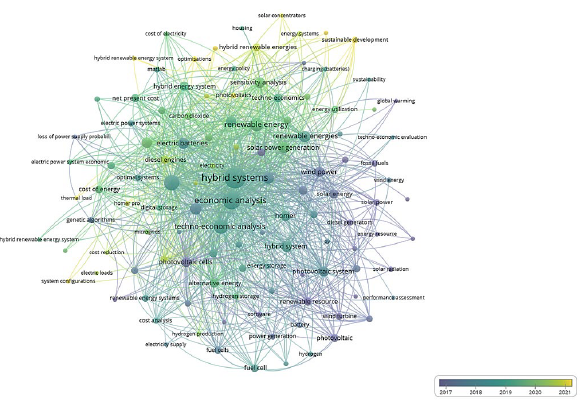
Source: Obtained in [19] by a search performed by the authors
Figure 1 Co-occurrence of all keywords
Likewise, it was observed that the annual growth rate of publications on models, studies and/or techno-economic analysis for hybrid power generation systems with renewable sources is 24.6%. The average time of publishing of the articles is only 3.14 years.
Fig. 1 summarizes the bibliometric study graphically and it shows the correlations and co-occurrences of keywords added in the articles over the years. On the one hand. this finding shows that that the most repeated words among all articles are "hybrid system" and "economic analysis" around the year 2019. On the other hand, the graph shows a predominance in words referring to renewable and non-renewable energies individually such as "solar energy", "wind power", "fossil fuels" and "diesel generators", while the keywords located in the time interval between mid-2020 to the present, have a more integrative and sustainable approach, such as "hybrid renewable energies", "sustainable development", "hybrid renewable energy system". The keyword analysis is relevant to this study, as it allows ratifying the relevance of the information collected to advance satisfactorily with the development of the SLR. Additionally, it can be deduced that there is a recent interest among researchers and academic institutions for the topic. The map shows a genuine interest in the subject, especially influenced by the desire to contribute to environmental sustainability and energy transition that the planet needs.
Fig. 2 depicts the most relevant sources of information. The highest number of published documents were reported the journals: Energy Conversion and Management, and Energy. Both journals reported 12 articles. The aforementioned media are academic journals of a scientific nature directed by Elservier.
After the bibliometric analysis was performed, the articles gathered from the Scopus database were complemented with those gathered from the WoS platform. The articles that did not meet search criteria were excluded, leaving only the potential documents to provide a complete and truthful answer to the research questions. Fig. 3 depicts the number of publications reported per year of selected scientific articles and the only review article [20] resulted for the SLR.
The articles were analyzed separately, and the necessary information from each was compiled and interrelated. It was possible to identify the main objectives this study intended to achieve. Besides, the SLR allowed extracting global and conclusive results, among them. The most stated objective was to determine the optimal efficiency or profitability scenario, reported in 42.1% of the papers and in second place, the goal established was to determine the techno-economic feasibility, which was reported by 26.3% of the studies.
All the articles analyzed throughout the documents assess the specific design or architecture of an electricity generation system. In the most frequent configuration, the system made up of photovoltaic solar panels, diesel generators and batteries (31.6%). Only one article [21], reported a configuration, based on a 100% renewable source system (wind, photovoltaic and biomass system); the other articles combined renewable and conventional systems to supply the energy resource in rural areas.
3.1 SLR answer to guiding questions
This section answers the research questions posed in the SLR, after having analyzed and compiled the necessary information separately from each of the articles and interrelated it with all the other articles to draw global conclusions. The research questions posed in the SLR will be answered below.
Q1: Which are thefunding sources used in the projects?
The funding sources or alternatives mentioned in the articles to obtain the budgetary resources that allow them to carry out the rural electrification projects with hybrid renewable systems are classified into three main categories. First, the projects that propose a private financing source, that is, when an organization or company finances the entire project with subsidies and grants from the local government. Second, the development of the project through public financing, where the government assumes all the costs of acquisition, installation, operation and maintenance of the system. Finally, the mixed or integrated financing, where the government invites local or foreign investors to finance the project.
Results show that 31.5% of the articles do not mention the source of financing of the project and 68.4% lean towards one of the mentioned categories or, at least, indicate the possibility of financing them with any of the three options. In addition, [22-24], the techno-economic information provided in the documents has the potential to significantly help governments to attract investors to take risks for this type of projects, given the high capital costs involved in the implementation of this type of systems, assuring the most reliable options for both financing sources and consumers.
Q2: Which are the economic variables of the models found?
Table 2 highlights the main economic factors found in the articles analyzed which are classified as input and output variables. For the output variables, the equations used are also shown; where C t is the total annual cost, L ann , ioad is the total energy consumption per year, i represents the real discount rate and N the number of years. For the ROI calculation, C iref is required which is the nominal annual cash flow for the base (reference) system, C¿ is the nominal annual cash flow for the current system, R proj is the project duration in years, C cap is the capital cost of the current system and C cap , re f represents the capital cost of the reference system.
Other important variables to consider in the study of this type of systems are technical variables such as installed capacity, number and size of the system components, operating efficiency, surplus electricity generated, satisfied and unsatisfied loads, and performance.
Environmental variables are considered, such as environmental conditions, climatic data of the area, availability of energy resources, greenhouse gas emissions, carbon dioxide emissions, life cycle assessment of pollutant emissions, particle measurement and fraction of renewable energy in the system.
Alternatively, social variables need to start being considered. They represent the conditions of the community that will benefit from the electrification systems and measure the social impact generated once the system is installed, among them are the local needs, the socio-economic stratum, level of education and debt capacity of the population. Some articles included social assessment. In [23], a detailed social analysis was conducted, taking into account quantitative parameters of social development such as the Human Development Index (HDI). The impacts considered the electricity consumption of a community and reflects the economic and social development of their residents. The local transportation-based employment (LT) which consists of a viable transportation plan that can create greater employment opportunities downstream. And, the job formation factor (JF) which determines the number of jobs formed by each component of the energy system.
Q3: What are the financial models applied to the development of the projects?
A financial model mathematically captures the financial situation of a company or a project taking into account all the parameters or aspects of its economic activity. These models usually involve the net present value, asset prices, interest rates, yields, amortization periods, credits, internal rates of return and discount rates, among others [26].
The financing of hybrid systems with renewable energies in rural areas is characterized by requiring a high initial investment., it is traditionally regards as a significant risk, due to the long recovery periods, the uncertainty of renewable energy sources, and service demand, problems with skilled labor, supply logistics management and poor transportation facilities, which raise costs and reduce the profitability of the projects [27].
For this reason, it is very necessary to implement financial alternatives that favor the implementation of this type of technologies in rural areas or areas not connected to the national energy systems, which promote and boost the deployment of these remote communities, improving the quality of indexes.
The major part of the papers is limited to obtain the NPC, including the costs of purchasing power from the grid, while revenues include salvage value and grid sales revenues. They also analyze the LCOE variable, which is understood as the average cost per kWh of useful electrical energy produced by the system [24].
The financial models presented nominal cash flows for the useful life of the project (between 20 and 25 years). Capital costs were divided by each system component and replacement, operation and maintenance, fuel (if applicable), recovery cost and amortization period were considered. Likewise, economic outputs of this type of projects are NPC and LCOE [27-29].
Kolhe, Ranaweera, and Gunawardana proposed two performance scenarios to respond to the particular financial conditions of the project [30]. The first scenario evaluated the system without connection to the national grid, which had low capacity and could only feed a limited number of devices. Therefore, if any consumer requires a greater amount of electricity, they will have to incur in higher capacities investments. For this case, the funding can be provided by the private sector, the government or a mixed way considering government subsidies. The second scenario had connection to the national grid, but it would be necessary to expand transmission and distribution lines, as to build new power plants. This situation would generate losses along the lines and provide low power quality (low voltage). Both alternatives entail determining consequences for the financial model. The authors proposed an innovative mechanism that after ten years of the hybrid system operation, the community will have access to electricity from the national grid, i.e., the transmission of energy from a power plant will be extended to this rural area located in an Asian island state. In the first 10 years of the system's operation, the community will purchase electricity from the independent power producer, once the national grid is available, the hybrid system can be connected to the grid and all the power generated by can be sold to the national grid. The LCOE of the project considered capital costs, operation and maintenance cost, battery and generator replacement costs, payback values, and profits earned from selling electricity to the grid after grid connection.
Another application for rural areas using renewable hybrid systems and benefiting the surrounding populations with the surplus electricity is to cover the needs of water pumping and public lighting. In [31,32], the supply of electricity to base transceiver stations (BTS) for remote telecommunications located in rural areas were presented. In this situation, the financial model can be classified as a donation by a private entity to the inhabitants of these rural areas.
Table 3 presents the LCOE informed by the authors for different hybrid electric generation systems. It can be observed that 44.4% reported a cost between 0.1 and 0.2 dollars per kilowatt-hour and 27.8%, a cost higher than 0.3 dollars per kilowatt-hour. It is important to mention that the costs presented in the table are sensitive to exchange rate variations and are subject to the specific technical and environmental conditions of each system.
Both variables are studied in certain periods of useful life of the optimized hybrid systems or their individual parts, with which comparisons are made in economic terms of different configurations, sensitivity analysis to study their variations in the face of parameter changes and finally decide which is the optimal system according to the restrictions, needs and availability of resources.
Q4: What challenges and suggestions have been identified for future projects?
The most relevant challenges identified in the selected articles refer to the fact that this type of electricity generation systems in rural areas involve high investment costs with significant financial risks, quite long investment recovery times, both for conventional lenders (such as banks) and for any local or international investor [27]. This situation prevents low-income communities from acquiring the systems and assuming the high costs of operation and maintenance once they are installed [21].
In addition, a lack of support of governmental with respect to fiscal and economic policies, and incentives that foster affordable investment and financing environments for the implementation of the systems in these remote communities.
Some difficulties by the use of hybrid system are suggested by [24]. The following must be considered to succeed a hybrid system for rural applications: fuel supply, sudden increase in demand during the lifetime of the project, calculation of the grid balancing distance, and surplus electricity. Regarding the operational feasibility, the hybrid systems are highly dependent on the availability of resources and potential sources in the implementation sites, such as solar radiation, wind speed and the distance between the source and the load point [28]. Likewise, the presence of skilled labor in the rural markets to carry out an adequate validation of the systems in the design phase are need [27].
Among the suggestions mentioned by several authors for future projects on the proposed topic, the evident need to include social and cultural components in the determination of the feasibility of the projects is highlighted. It allows the specific and precise designs and planning that broadly meets communities' long-term needs [23].
Most of the authors agree that energy storage in hybrid systems comprised solely of renewable sources is an important issue for providing continuity of energy supply and stabilizing power fluctuations, which characterize these systems. Additionally, new and improved energy storage technologies such as supercapacitors, pumped storage, flywheels and hydrogen should be explored [24]. This, considering the importance of having energy storage mechanisms in hybrid systems to give continuity to the supply of the resource and stabilize power fluctuations, characteristic of these systems.
Harish, Answer, and Kumar, proposed to mix smart technologies with hybrid power generation systems, specifically the use of the Internet of Things (IoT), machine learning and data science to develop smart rural microgrids [20].
Regarding the financial analysis of [29], it is suggested to consider the trade-off of electricity generation systems made up of renewable energy, which as mentioned above have very high capital costs, but operating costs are low and in the long term will be economically more profitable with respect to systems using fossil fuels i.e., diesel.
It should be noted that utility resource planning becomes extremely reliable when resilience evaluation data is provided, as it promises a more resilient grid, results in minimal risk to investors and insurers, and less reliance on incentives [20].
4 Conclusions
As a result, it is possible to state that the 19 articles selected complied in their entirety with the quality and relevance of their information, being able to obtain relevant and pertinent conclusions to the research questions posed for the development of the RLS. Thus, it became evident that the main objective of 42.1% articles was to determine the optimal efficiency or profitability scenario including technical, economic, environmental, and social parameters.
The annual growth rate of the publications is 24.63%, with an average age of 3.14 years. This shows a marked interest in studying and deploying hybrid power generation systems based on renewable energy sources for rural areas. The number of researchers from public and private institutions interested in contributing to environmental sustainability and energy transition has increased in recent years.
In this study, the origin for the reported articles were strongly predominated by Asian countries, such as India, Iran, and Pakistan. For the context where this paper is proposed, it was evidenced the little participation of Latin American countries in the development and reporting of publications on the topic. This reflects the imminent need for Latin American countries to conduct a more in-depth techno-economic analysis of hybrid systems for rural electrification.
Referring specifically to the economic analysis, the sources of financing identified in the articles were private, public, and mixed, which assume all the costs of acquisition, installation, operation and maintenance of the different systems. In addition, it was possible to identify the most usual economic variables used: LCOE, NPC, and ROI. As economic indicators, they allow the comparison between different designs of hybrid systems, the feasibility determination. The major part of the articles limits their financial analyses to obtaining the aforementioned economic variables provided by the simulation software and do not carry out more detailed modeling considering environmental, social and sustainability contributions.
Finally, the authors assert the importance of the government support in the implementation of a public policy and economic incentives to support the capital cost reduction, and gathering rural electrification projects with hybrid systems. Governments must guarantee innovation and research in their countries, creating collaboration opportunities, and exchange of technologies that allow building a more sustainable and environmentally friendly world.














